The Full History of Animals In Space
16th Apr 2024
Our furry friends have always taken the rap for us in the most dangerous circumstances. Space exploration has been no exception. The tracks for human crewed spacecraft were paved by satellites with a variety of animals on board. Who were those unremarkable heroes, how many were there, and what were their fates? This article reveals the entire history of animals in space from A to Z.
Why Do We Send Animals Into Space?
The main purpose of sending animals in space has been to study the effect of spaceflight on living organisms. With the invention of the first rockets, it was only a matter of time before people would be sent into space, so scientists had to understand what risks and problems astronauts might face beyond Earth and how to prevent or solve those problems. As usual, our little friends came to the rescue.
They already have prior aviation experience, well, maybe not these individuals, but we have a history of doing this. Since the beginning of the 20th century, cats, dogs, roosters, and even a piglet have flown on zeppelins and aeroplanes. But space was a more difficult challenge. Animals were supposed to help test the performance of various life support systems, measure the level of body exposure to overload, vibration, temperature, sound and noise effects of varying intensity, and cosmic radiation, and also study the effect of microgravity on biological processes such as growth, development, metabolism, blood circulation, immunity, behaviour, etc. In addition, the animals could demonstrate the possibility of surviving and returning to Earth after flight, which was an important step in preparing for crewed missions.
Our little brothers honourably completed their task. Their flights helped avoid many dangers and save the lives of dozens of human astronauts. But let’s start with the beginning.
What Animals Have Been In Space?
Various piloted and unpiloted missions have sent a wide variety of fauna beyond our planet: insects, rabbits, guinea pigs, rats, mice, quails, newts, frogs, snails, turtles, and even some species of fish. Attempts to launch hamsters and geckos are also known. However, the most famous animals in space were the dogs, monkeys, and cats that flew aboard Soviet, American, and French rockets and satellites.
First Creatures In Space
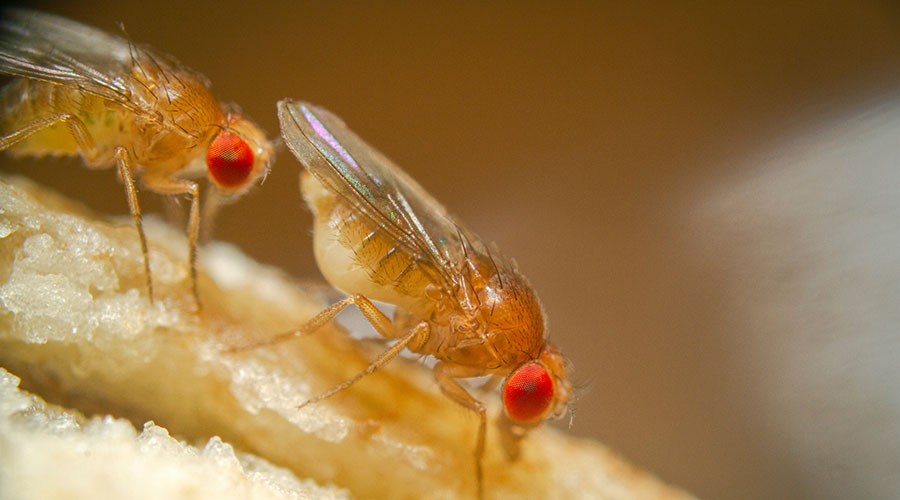
The first creatures on a spaceflight were fruit flies. They were launched on a captured German V-2 ballistic missile from the White Sands Test Facility in New Mexico, USA, in February 1947. The insects reached an altitude of 108 km; that is, they passed the Kármán line beyond which space begins, and they returned safely.
Why flies, in particular, were chosen? The V-2 rocket was small, and flies were ideal passengers for flight due to their compact size and weight, which made them easier to accommodate and saved fuel consumption. In addition, fruit flies have a genetic makeup similar to humans, so they were considered suitable subjects for testing and research. After safely removing the flies from the capsule, scientists discovered that their genetics had not been altered by radiation, thus opening the way for further research.
But Can a Fly Fly In Space?
In outer space, this is impossible since the cosmic environment is almost a vacuum, and flight using wings requires air resistance. In spaceship conditions, there is air but very little gravity. Experiments with flying insects showed that houseflies (Muscus domestica) were mainly limited to walking on the walls. When they flew, they could control movement in all three axes, but their flight lasted only a few seconds. However, after returning to Earth, the flies’ motor activity increased significantly.
What Was the First Mammal In Space?
In 1948, an American rhesus macaque named Albert I could have become the first mammal in space. However, the V-2 rocket did not go beyond the Kármán line, and Albert died during the descent.
The animal was placed in a tiny capsule in the rocket’s detachable nose compartment. At a flight altitude of 62 km, the compartment separated safely and began its descent. But the parachute opened too late — only 8 km from the surface. The high speed of the fall caused a sharp jerk, the parachute was torn to shreds, and the head compartment crashed. However, likely, Albert died much earlier from suffocation because of the very cramped compartment in the capsule.
Did a Monkey Go to Space?
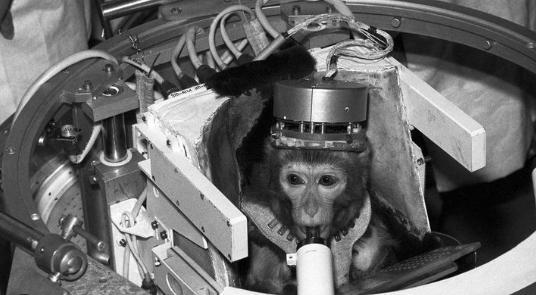
A year after the unsuccessful flight of Albert I, American engineers prepared a new experiment. They lengthened the nose compartment of the rocket to accommodate more measuring instruments, made a new parachute, and provided the animal with a special breathing mask.
On 14th June 1949, a V-2 rocket with the rhesus macaque Albert II on board crossed the Karman line, rising to an altitude of 133 km. Telemetry conveyed a lot of valuable information about the animal’s behaviour. However, during the descent to Earth, the parachute broke, and, at 340 seconds of flight, the capsule crashed to the ground. The impact was so strong that it formed a 1.5 m deep crater, and the first monkey in space died.
Did All the Animals That Went to Space Die?
Fortunately, no. However, while the US Air Force was experimenting, the mortality rate was very high. Over 10 years and out of 11 suborbital flights, only two were completely successful, and out of 13 primates, only four survived. In 1959, NASA took over the matter and flight performance increased significantly.

On 21st January 1961, the chimpanzee Ham made the first suborbital piloted flight on the Mercury-Redstone 2 spacecraft to an altitude of 250 km. During the flight, Ham was dressed in a spacesuit like a real astronaut and even performed a manipulation that he was specially trained to do — move a lever. Ham’s flight actually “opened the door” to spaceflight for people — after him, the first American astronauts flew on the Mercury spacecraft.
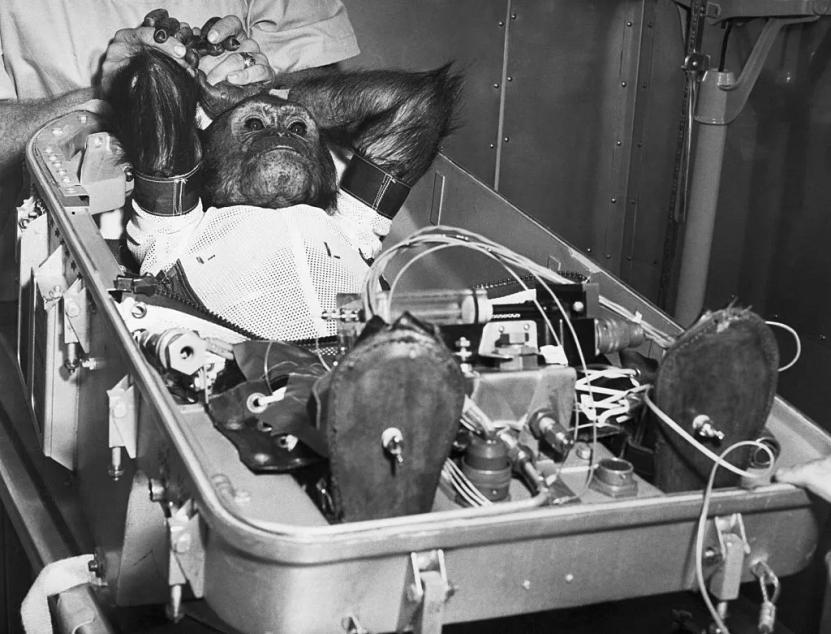
After Ham, the Americans sent monkeys onto spaceflights two more times. Enos the chimpanzee launched on Mercury-Atlas 5 on 29th November 1961. He successfully circled the Earth’s orbit two times and returned safe and sound.
In 1969, Bonnie, a male pig-tailed macaque, was sent into orbit as part of the Biosatellite programme. The flight was supposed to last 30 days, but on the ninth day, the mission had to be aborted due to the primate’s poor health. Bonnie was successfully landed, but a few hours later, he died from a heart attack in the doctors’ arms. The tragedy caused a scandal among the public, and the US Congress banned the use of monkeys in spaceflight experiments.
After the United States, four more countries launched monkeys into space:
- France – 1967;
- Argentina – 1969-1970;
- Iran – 2011-2013;
- Soviet Union and Russia – 6 flights under the BION programme in 1983-1996.
Altogether, 32 monkeys went on spaceflights, each with one mission. 14 animals died during the flight or shortly after it. After 1996, no experiments with primates were carried out.
Soviet Dogs in Space
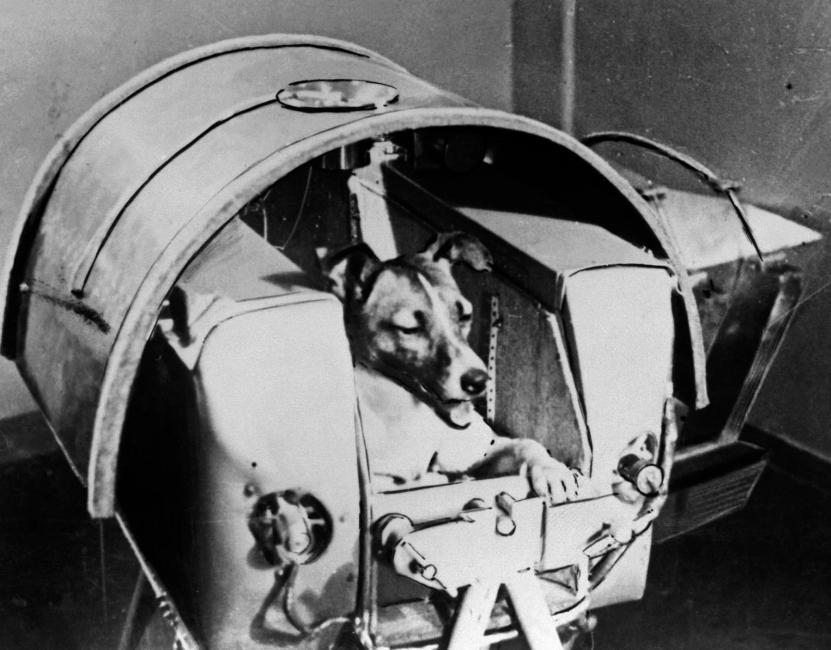
The first dogs in space were mongrels Dezik and Tsygan (Gypsy), who made a suborbital flight on a Soviet R-1B ballistic rocket to an altitude of 101 km on 22nd July 1951. The Soviets lagged behind the United States in animal experiments by almost three years, but their first animals in space survived and were not harmed at all. Encouraged by their success, the Russians decided to send a dog into orbit, but they were clearly in too much hurry.
On 3rd November 1957, a month after the launch of the first artificial satellite, Laika became the first animal in outer space but, unfortunately, did not survive since, at that time, the USSR did not yet have the technology to return a spacecraft from orbit. Laika was supposed to live onboard Sputnik-2 for seven days but died after five hours from overheating, fear, and stress (the satellite did not have a thermal regulation system). Laika was simply sent to die for the sake of scientific achievements, and this caused a storm of indignation in the international community. It took the Soviet “zoological cosmonautics” three years to rehabilitate itself.
The names Belka (Squirrel) and Strelka (Little Arrow) are perhaps the most famous of the animals that survived in space. They were launched on 19th August 1960, by Sputnik 5 and returned triumphantly after a 25-hour flight, making 17 orbits around the Earth. The USSR’s authority was restored, and Strelka even helped to melt the Cold War ice a little. A year after the flight, she safely gave birth to six puppies, one of which, named Fluffy, was presented to the family of US President John F. Kennedy.
Experiments with dogs continued until 1966. In just 15 years, 50 four-pawed astronauts went on spaceflights — 48 Soviet and 2 Chinese. 20 Soviet dogs died.
Cat Felicette
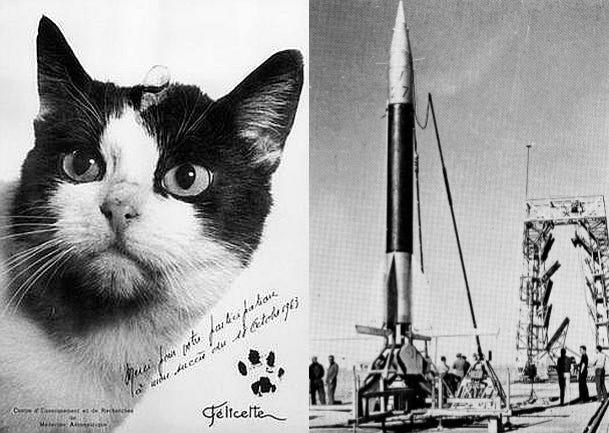
The first cat to go on a spaceflight was the French cat Félicette. On 18th October 1963, the animal was launched in a capsule aboard a Véronique AG1 rocket from the Colomb-Béchar launch site in the centre of Hammaguir in the Algerian Sahara Desert. The French explained their extravagant choice of an animal astronaut as follows: The Earth is only a temporary abode for man, and our real home is space. And who is the first to enter a new home if not a cat? The French were preparing a whole team of cat astronauts, but ultimately, the choice fell on a black-and-white kitten under the number C341.
C341 returned to Earth alive and unharmed. She became popular, and the press came up with the name Félicette, in honour of Felix the Cat from the silent films, which was similar in colour. Unfortunately, Félicette was euthanised two months later so that scientists could perform an autopsy to see how the flight affected her body. But they didn’t learn anything new.
Brazil and Iran also planned to send cats on spaceflights, but their plans never came to fruition. To this day, Félicette remains the only cat astronaut in the world.
Which Animal Went to the Moon First?
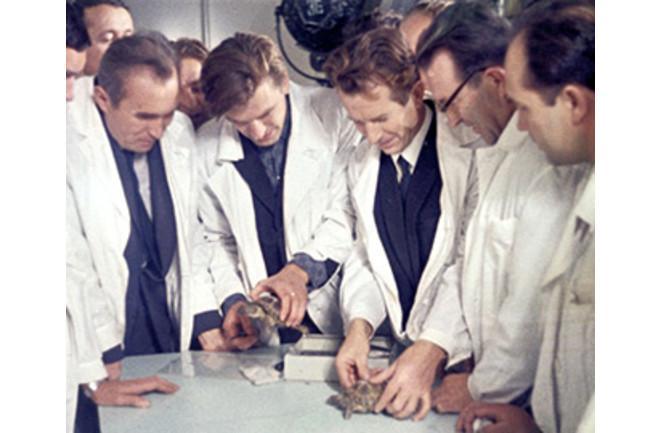
On 15th September 1968, the Soviet Zond-5, with reptiles on board, was launched to the Moon for the first time in history. The two Central Asian tortoises were accompanied by fruit flies, flour beetles, and several plant species. The astronaut turtle was chosen as a test subject because it did not require equipment to feed in zero gravity — these species can go without eating or drinking for a week and a half. The probe made a successful flyby of the Moon and, seven days after launch, returned to Earth, splashing down in the Indian Ocean. The animals were removed from the apparatus only at the beginning of October when the reptiles were delivered to Moscow. The turtles were active and ate with great appetite, which was not surprising: they lost about 10% of their weight during this journey.
After that, the turtles flew to the Moon three more times — in the Zond-6 (November 1968), Zond-7 (August 1969), and Zond-8 (October 1970) missions. The turtles of Zond-6 died due to the descent vehicle falling to Earth from a height of 5 km after an abnormal release of the parachute. The Zond-7 and Zond-8 turtles returned safely to Earth. In 1975-76, the USSR also launched turtles into orbital flights aboard the unmanned Soyuz-20 spacecraft and aboard the Salyut-5 orbital station. These missions set a 90-day record for an animal stay in space.
On 3rd February 2010, two turtles made a successful suborbital flight on a rocket launched by Iran.
Other Animals That Lived In Space
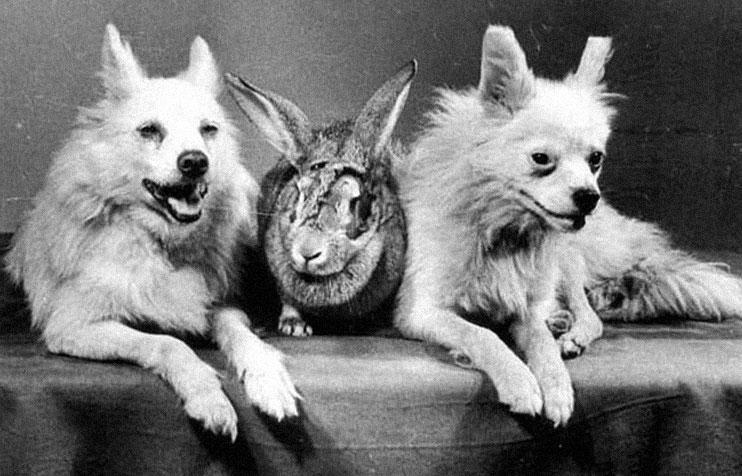
In total, the history of cosmic research counts around 500 different animals in space. Let’s find out who else went on spaceflights besides dogs, monkeys, cats, and turtles.
- In 1959, the Soviets launched the first rabbit in space. A pregnant animal named Marfusha went on a flight in the company of two dogs — Otvazhnaya and Snezhinka. All animals survived the flight in good health, and upon returning to Earth, Marfusha gave birth to healthy offspring.
- The first guinea pigs and rats went on a spaceflight on December 1, 1960, on Sputnik 3. The satellite was not returned for technical reasons: the entire crew (dogs Pchelka (Little Bee) and Mushka (Little Fly), guinea pigs, rats, and mice) died.
- In March 1961, frogs were on a spaceflight for the first time on board the Sputnik 9 spacecraft, along with mice, guinea pigs, a dog Chernushka (Black Spot), and a dummy of a human, which was called Ivan Ivanovich.
- In 1973, American mission Skylab 3 carried the first fish on a mission. After that, the fish flew 17 more times on the Apollo, Soyuz, Space Shuttle, BION, and Progress missions.
- In 1974, the spiders Anita and Arabella travelled to low orbit aboard the Skylab probe. The webs they wove turned out to be generally the same as on Earth — only the threads were not constant in thickness and were generally thinner than they should have been.
- In 1978, quail eggs were first delivered to Earth orbit onboard the Cosmos 1129 spacecraft. True, the experiment did not work out quite well due to the hard landing, which broke almost all of the eggs. Nevertheless, scientists still received several quail embryos, which answered the most important question: conception in space is possible. In 1999, the experiment was repeated — sixty quail eggs were sent into orbit. Of these, 37 chicks hatched, and three managed to return to Earth alive.
- Newts were first put into orbit as part of the Soviet BION program in 1985 to study the regeneration properties in the cosmic environment.
- In 1991, onboard the Columbia shuttle, the United States sent over 2,000 jellyfish polyps, enclosed in flasks and bags filled with artificial seawater, into orbit. To encourage the polyps to swim and reproduce, astronauts injected chemicals into the bags. By the time the mission was completed, there were more than 60,000 jellyfish in space.
- In September 2007, a female cockroach, Nadezhda (Hope), was launched on the Russian spacecraft Foton M-3. She became the first animal from Earth to give birth to offspring conceived in space: after landing, Nadezhda gave birth to 33 nymphs.
- In November 2009, shuttle STS-129 took Painted Lady (Vanessa Cardui) and Monarch butterflies on a mission for a school experiment and thousands of C. elegans transparent nematodes (roundworms) for long-term weight loss research.
- In 2011, Endeavour STS 134 final mission launched two golden spiders, Gladys and Esmeralda, as well as a colony of fruit flies as a food source to study the effects of microgravity on spider behaviour. Tardigrades and extremophiles have also been sent into orbit.
- In October 2012, 32 medaka fish were delivered to ISS by Soyuz TMA-06M for a new aquatic habitat in the Kibō module.
- In February 2013, Iran became the latest country to send animals on spaceflights. A mouse, two turtles, and several worms were launched on the Kavoshgar-3 rocket and returned to Earth alive.
- In July 2014, Russia launched its Foton-M4 satellite into low Earth orbit (575 kilometres) with one male and four female geckos to study the effects of microgravity on the reptiles’ reproductive habits. However, communication with the satellite was soon lost. All the geckos froze to death.
- From September 2014 to June 2018, SpaceX sent mice to ISS for research four times.
- In January 2019, China landed the Chang’e 4 spacecraft on the far side of the Moon with insects and seeds on board (rapeseed, cotton, potatoes, Thale cress, fruit flies, and yeast). Only the cotton plant sprouted but soon died.
- In June 2021, SpaceX’s CRS-22 resupply mission delivered approximately 500 water bears and 100 babies of Hawaiian bobtail squid to the ISS.
How does space affect animals?
Over the years of experiments, scientists have found that animals in space are influenced by three main factors:
Radiation
Cosmic radiation is stronger in space than on Earth. It can damage DNA, cause mutations, disrupt cell function, and increase the risk of cancer and other diseases.
Microgravity
The lack of gravity affects the physiology and behaviour of living organisms. For example, microgravity can cause muscle atrophy, bone loss, fluid redistribution, cardiovascular changes, and altered sensory perception. Microgravity can also affect development, growth and reproduction. For example, it has been found that some animals, particularly insects, experience shorter lifespans, smaller body sizes, and lower birth rates in microgravity conditions.
Stress
Spaceflight can be stressful due to factors such as confined rooms, isolation, noise, vibration, temperature changes, and unfamiliar surroundings. Stress can affect the immune system, metabolism, and behaviour. It has been observed that some animals, such as mice, have increased levels of cortisol, the stress hormone, and decreased levels of melatonin, the sleep hormone. Stress can also affect social interaction and communication in animals. For example, some monkeys experience decreased levels of vocalisation and behaviour related to grooming.
Since different animals are, to a certain degree, similar in their physiological characteristics to humans, studying the influence of space on their organisms is a determining factor for increasing the astronauts’ safety on long-term missions.
Are there any animals in space right now?
Yes. They live on the International Space Station (ISS). Spiders, cockroaches, mice, fish, ants, water bears, and other species are periodically delivered to the ISS to conduct various biology, medicine, astronomy, and ecology experiments. For example, recently, scientists managed to grow mouse embryos on ISS. And research continues.
So, we can assume that space has its own animal watch, which serves for the benefit of humanity and all life on Earth. And we are grateful for this, just like we are grateful to all the other animals that have ever been in space.
Resources
- Gray, T. “A Brief History of Animals in Space,” NASA, 1998.
https://history.nasa.gov/animals.html - NASA, “Skylab 3: Return to Skylab,” July 25, 2018.
https://www.nasa.gov/feature/skylab-3-return-to-skylab - Water Bears in space
https://www.nasa.gov/podcasts/houston-we-have-a-podcast/water-bears-in-space/ - 9 Unusual Things Researchers Launched Into Space for Science
https://www.discovermagazine.com/the-sciences/10-unusual-things-researchers-launched-into-space-for-science - NASA Space Science Data Coordinated Archive, “Bion 7,”
https://nssdc.gsfc.nasa.gov/nmc/spacecraft/display.action?id=1985-059A - Uri, J. “60 Years Ago: Soviets Select Their First Cosmonauts,” NASA, February 25, 2020.
https://www.nasa.gov/feature/60-years-ago-soviets-select-their-first-cosmonauts - Rodent Research
https://www.nasa.gov/general/rodent-research/
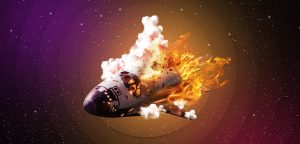



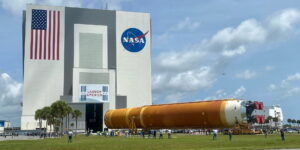
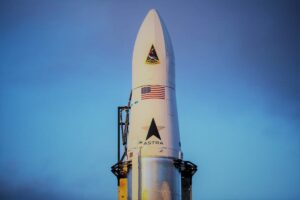
Thank you for your comment! It will be visible on the site after moderation.